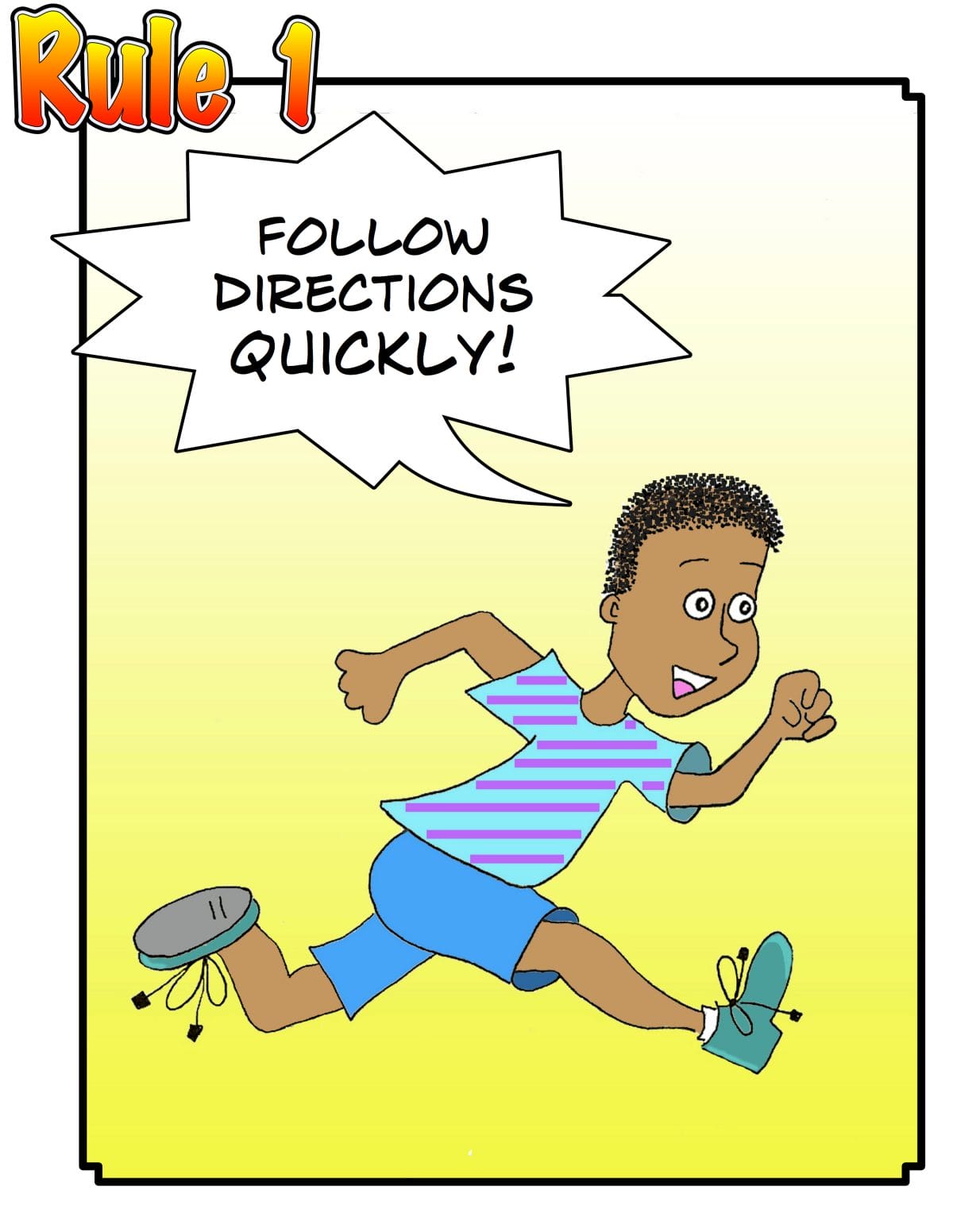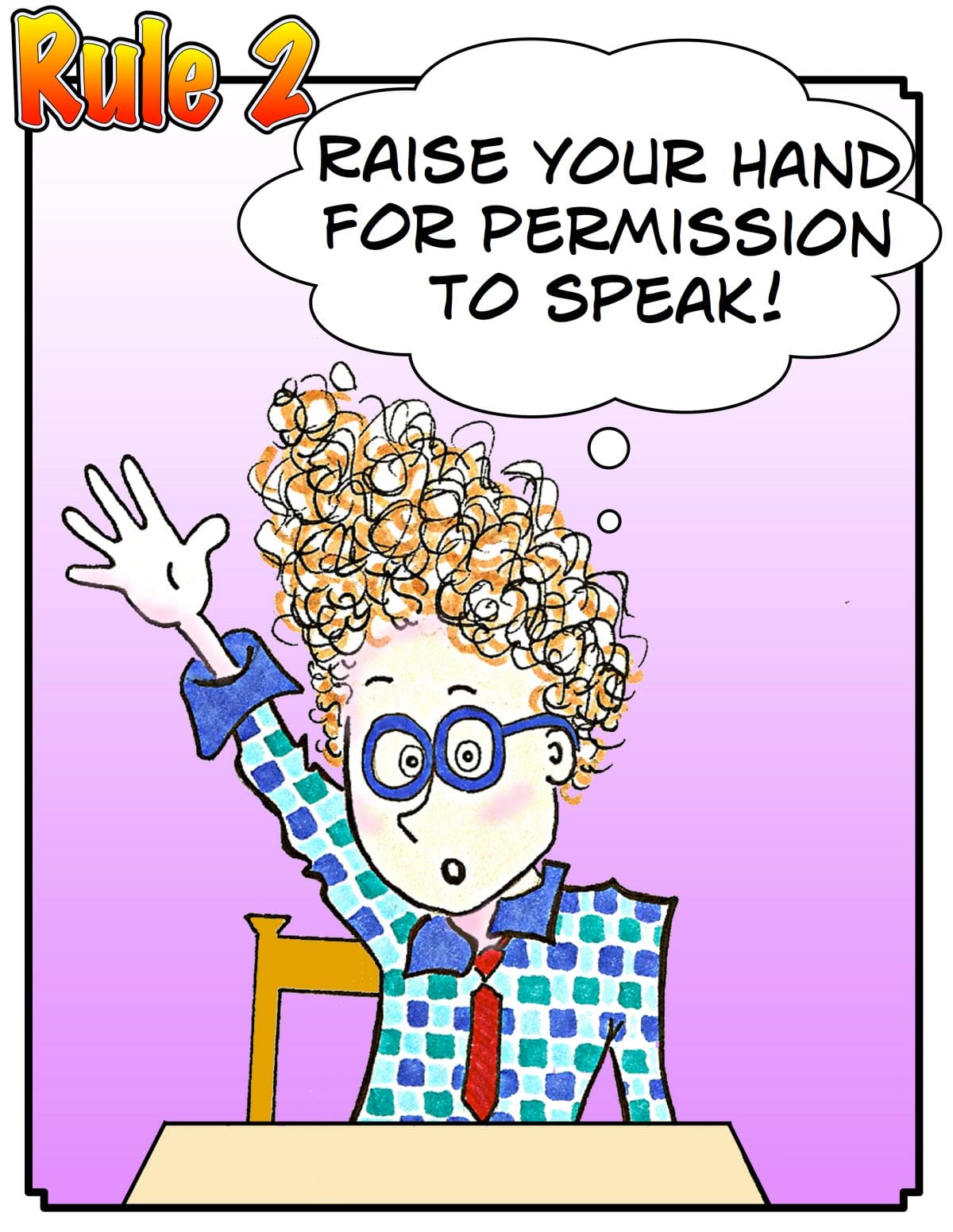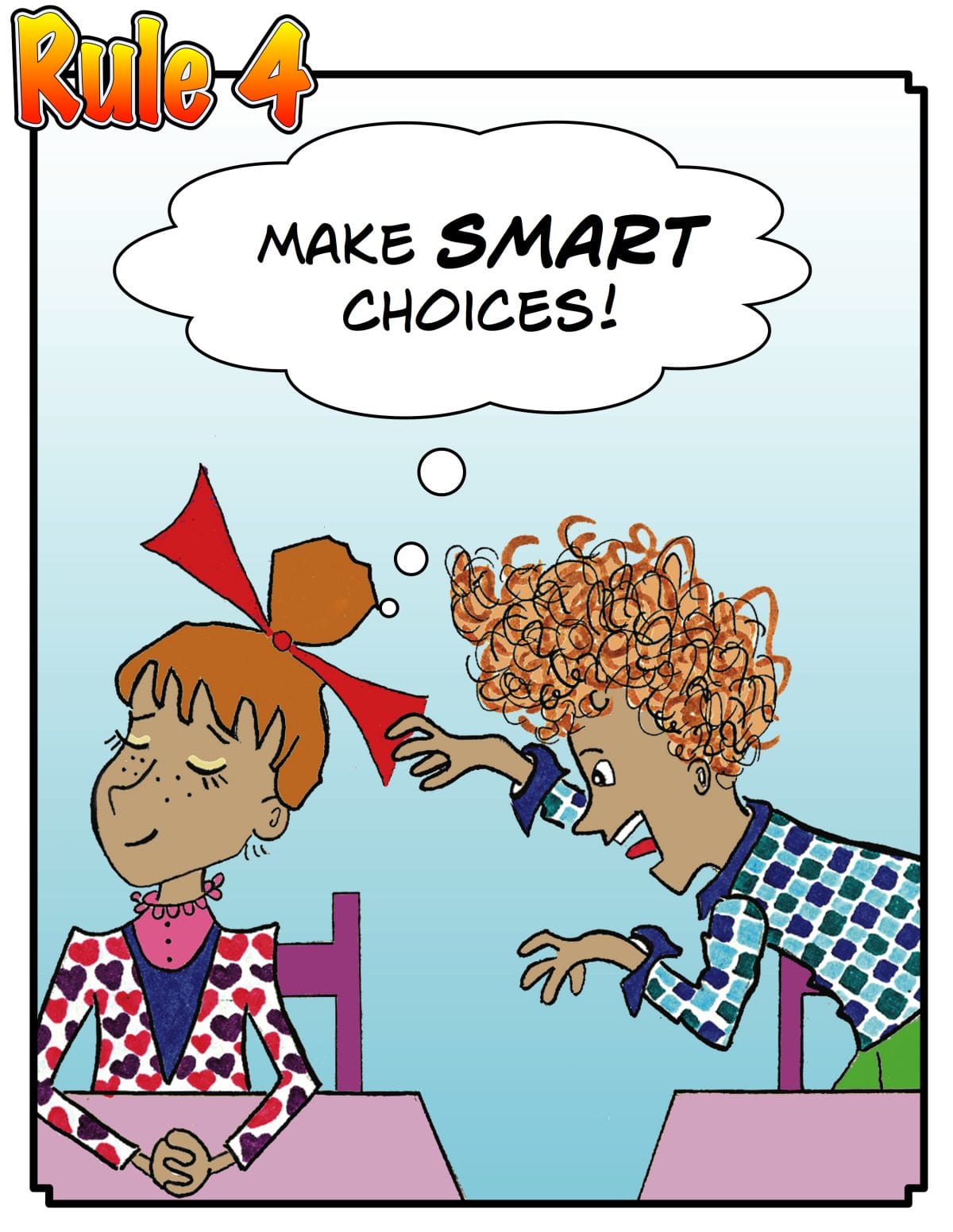Classroom Rules
Weaving Rules Throughout Daily Instruction





WBT’s Classroom Rules are not just wall posters. We weave our guidelines throughout daily instruction increasing students’ engagement, decreasing problem behaviors, and boosting Funtricity!
Join our Super Improver Facebook® group to discuss these amazing training videos:
- Rules 1 and 2 with Platinum Trainer Joanna Willis
- Rules 3 and 4 with Platinum Trainer Joanna Willis
- Rule 5 and Diamond Rule with Platinum Trainer Joanna Willis
- Class Rules for Inclusive Classrooms with Platinum Trainer LaKedria Lozano
Below are three simple steps to implement our Classroom Rules:
Step 1: Teach the Rules and Gestures.
You cannot use the rules if students don’t know them! Teach the gestures for each rule using the WBT Magic Circle.
Step 2: Rules Review.
Call out a rule number; students repeat the rule and perform the gesture. The more entertaining the review, the more engaged your kids. Best of all, develop leadership by having one or more students lead a Rule Review whenever the class enters the room: morning, after each recess, music, art … and especially following lunch!
Step 3: Rule Call Out.
When a student breaks a rule, instead of scolding, which can fuel a Beloved Rascal’s fire, activate a Rule Call Out. Call out the rule number; the class repeats the rule and performs the gesture. Using this procedure addresses the behavior without direct conflict, uniting the class behind your leadership.
Additional strategies for each rule are explained below. Explore our collection of WBT Classroom Rule Poster downloads!
View this post on Instagram
Rule 1: Follow directions quickly
The secret to lightening fast, classroom transitions.
Slow transitions from reading to writing to math to lining up, not only wastes time but also breeds disruptive activity. Here are three easy steps to weave Rule 1 into daily instruction:
Wrong Way – Right Way: If you need faster transitions, teach students to transition quickly …by practicing Wrong Way – Right Way. Want students to move rapidly to the rug? Have them practice the wrong way, turtle slow. Celebrate Beloved Rascals that perform the wrong way tremendously well, because that’s what you asked them to do! Next have them practice rug sitting the right way. You’ll see tremendous improvement that can be rewarded with Starries or Super Improver® points.

The Three-Peat: You say, “Yellow folders out!” They respond, “Yellow folders out! Yellow folders out! Yellow folders out!” as they pull out their yellow folders. When the folder is open to the correct page, we suggest kids shoot both hands upward, waggle their fingers, and happily murmur, “Yea!” They continue their celebration, until you sweep a hand dramatically through the air. You can use the celebration time to help slower students. Use this strategy for any transition: lining up, moving to the rug, sitting down, taking out a pencil, turning to a page in a book.
The Timer Game: An easy way to turn transitions into a game, is to use a timer to set and break records. Before any transition, set a timer. Record that time on the board: this is the class record. Before the next transition, set the timer again. If you break the record, celebrate with a Super Improver Star! If you didn’t break the record, chant, “We got grit, we don’t quit!” You can also play by counting up, instead of a timer. Simply count up from 0, telling your students you will count slower when you see Glorious Kindness and positive Leadership, and faster when you don’t!
Rule 2: Raise Your Hand for Permission to Speak
Taming Blurters
In the middle of your Civil War lesson, a chatty kid blurts out, “What time is lunch?!” You blurt back, “How many times do I have to tell you to raise your hand to speak! Raise your hand! Raise your hand!” You match your student’s emotional blurting, with your own.
Welcome to Teaching Purgatory. Too often, we treat students like we don’t want to be treated. Chained together for a year, we mirror their outbursts with our own. We try to put out a kid’s little flame, with our big fire.
Why do children (and teachers) blurt? In scientific terms, there are more connections from the brain’s limbic system to the pre-frontal cortex than vice versa. Translation: emotions control reason more easily than reason controls emotions. Another scientific point: our brain’s mirror neurons condition us to imitate behavior we observe. You blurt me. I blurt you. And so on. Scolding doesn’t change behavior.

If chastising a child transformed them into a model student, Coach B would write best sellers, “Scold Like a Pro!,” “The Five Secrets of Power Chastisement,” “If They’re Not Crying, They Didn’t Get It: Confessions of a Former Sweetie Pie.” If scolding doesn’t change behavior, what does? Practice. You have your choice between two tennis coaches. One coach scolds you for your bad technique. The other coach helps you practice good strokes. Which one will improve your game? Don’t know what to do with an unruly student or class? Practice good behavior.
Wrong Way – Right Way: Play the game as described in Rule 1.
Rule Call Out: Use Rule Call Outs, as described at the top of the page, to tame blurting behavior.
Timer Game: Play the game as described in Rule 1. This time you are playing to see how long your students can go without blurting. Set a timer. When the first student blurts, use a Rule Call Out. When a second student blurts, use a Rule Call Out again. The third blurter gets a Rule Callout and stops the timer. Write this time on the board as this is the class record. Use three blurters instead of one so the class works together as a team, and one student doesn’t sink the ship. Play again by reseting the timer, working to beat your record.
Rule 3: Raise Your Hand for Permission to leave your seat
Use the same approach for Rule 3 as you did for Rule 2. Rehearse the rule, “Raise your hand for permission to leave your seat” with the hand gesture; students raise their hands, then walk their fingers through the air. Then, use Wrong Way-Right Way.
Reynaldo, on your cue, leaves his seat without permission. Great job of breaking the rule. Reynaldo leaves his seat again, you call out Rule 3, and the kids exclaim, “Raise your hand for permission to leave your seat!”
If you practice the wrong way and then right way, five times a day, pretty soon you’ll see more right way behavior. No student ever wants to feel like they are doing something wrong… that’s why they deny they’re engaged in incorrect behavior.
“Maggie, stop doing that!”“I wasn’t doing anything!”
This is the wonder. With the procedures described on this page, you take a classroom disruption, blurting or wandering, and transform it into a classroom unifier. Whenever a rule is broken, a rule is strengthened.
That’s the way it is, my friends, in Teaching Heaven.

Rule 4: Make Smart Choices
The Ancient Secret for Wise Decisions
Let’s think about the first three Whole Brain Teaching classroom rules. Each will help solve one teaching problem. Implementing Rule 1, “Follow directions quickly,” will speed classroom transitions. Implementing Rule 2, “Raise your hand for permission to speak,” will produce orderly discussions. Implementing Rule 3, “Raise your hand for permission to leave you seat” will keep your classroom from turning into kiddie bumper cars.
Rule 4 “Make smart choices: Glorious Kindness, Positive Leadership, Selfless Courage, Invincible Grit, Brainy Creativity” is a much larger, grander principle.
Making smart virtuous choices is perhaps the fundamental rule for all human behavior, in or out of the classroom.

WBT educators have discovered that Rule 4 is wonderfully powerful. The rule covers every area of a student’s life at school, at home, out with friends, on the Internet, engaged in a sport or hobby, Everything. From childhood to adulthood, we need to make smart choices. Rule 4 is especially powerful in covering all varieties of disruptive student behavior, in or out of class.
Happily enough, implementing the Smart Choices rule is easy.
Smart Choices in Content: Discuss the smart and foolish choices made by characters in a story, famous people in a history lesson, kids in the lunchroom, athletes in a game.
Smart Choice Preview: Before beginning a calendar exercise or art activity, ask kids to discuss the smart and foolish decisions they could make. Here’s a key point. If a child claims, incorrectly in your view, that one of her choices was smart, you respond, “Okay. But what would be a smarter choice?” This may involve considerable discussion, but it’s worthwhile. Teach your pupils that smarter choices are always possible.
Virtue Calendar: One of the best ways to weave Rule 4 into every lesson everyday is to implement the Virtue Calendar, as part of our Character Education program.
Rule 5: Make our dear team stronger
The Rule of Rules
When we began to develop Whole Brain Teaching’s rules, our goal was to cover every classroom problem.
We wanted a couple of principles that were as specific as possible and one or two others that covered every variety of disruptive behavior. Thus, we have Rules 1-3 that target individual classroom problems. Rule 4 is marvelously general, addressing every decision a child can make. Rule 4 can be applied to any issue not covered by the first three rules.
So, why do we need Rule 5, “Make our dear team stronger?” Rule 5 addresses your most challenging students… the ones who will quarrel with you about Rules 1-4! Pupils who dawdle along, can claim they are following directions quickly. Chatty kids can claim they weren’t speaking to anyone. Your most challenging students can even deny they are out of their seat… when they are standing in the middle of the classroom! “I’m not out of my seat. I’m just getting my pencil sharpened.”

Of course, your most resistant spirits can argue that all their choices are smart, no matter how obviously foolish. So, what’s a beleaguered instructor to do? You need one rule that can’t be disputed. We’ve never discovered a child who could convince their instructor that their disruptive behavior made their dear team stronger. Kids, especially our Beloved Rascals understand teams, organized, rule following communities they participate in during online games, playground activities, or sports. Rule 5 is the argument stopper, the backtalk squelcher.
Following directions quickly, raising your hand for permission to speak or leave your seat, making smart choices … all these principles are team strengthening. With Beloved Rascals, Rule 5 is the Rule of Rules.
Diamond Rule: Keep Your Eyes on the target
The Diamond Rule is a recent addition to Whole Brain Teaching’s instructional jewels. Chris Rekstad, co-founder of WBT, told Coach B he had a truly remarkable collection of challenging kids. Foolish Coach, he didn’t believe him, and went to see for himself. Oh goodness! Even when Coach had his teaching engine fired up to its highest power, he kept thinking, “half these kids aren’t even looking at me!” Then, he thought how often, especially in the afternoon at conferences, a large handful of instructors found other objects of attention besides their dear teacher.
Instruction begins, and is maintained, by visual focus. Your kids won’t learn much, if they aren’t looking where they should be … at the speaker, their books, the board.
The gesture for the Diamond Rule, “Keep your eyes on the target” is pointing two fingers at your eyes, then pointing two fingers toward your audience. Explain the variety of targets in the room and how instructional targets shift from one activity to another. When anyone answers a question, the target is the speaker. When quiet reading is underway, the only target is you book … and so forth. You can introduce the Diamond Rule in the first minute of the first day or save it until later in the term. Like a miser, you’ll delight in the beauty of this pedagogical jewel.

Upgrades

